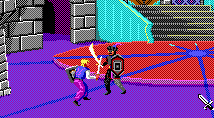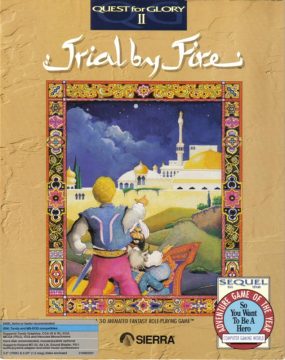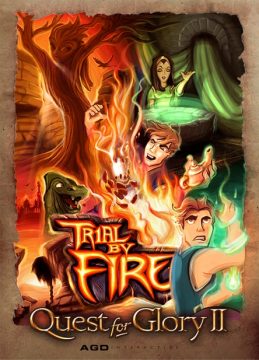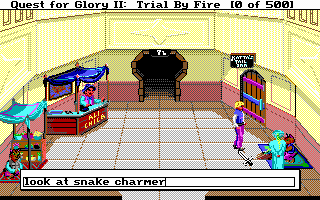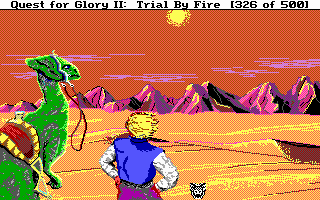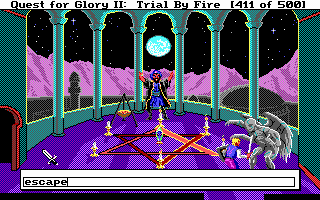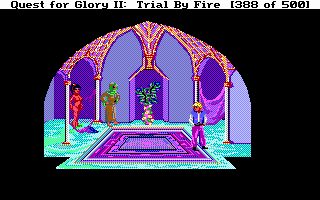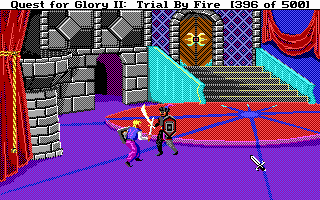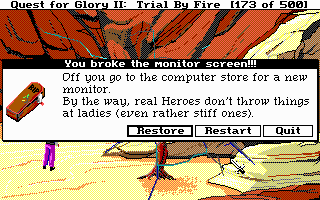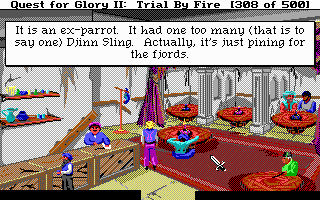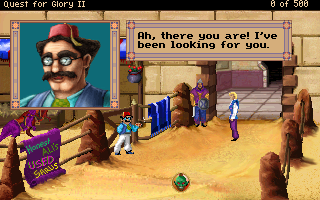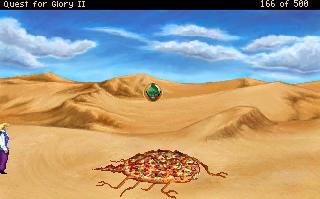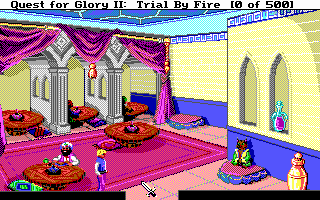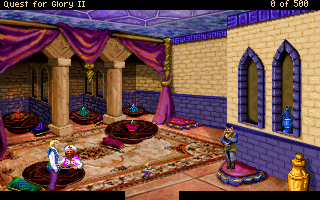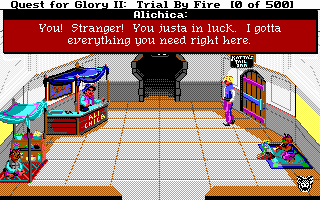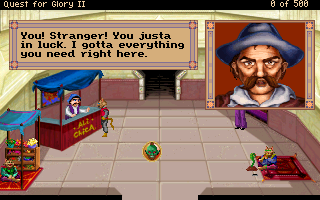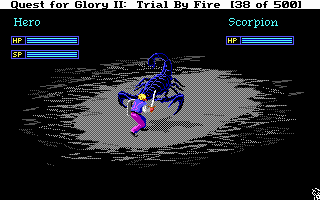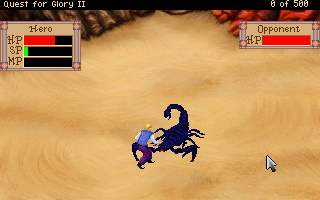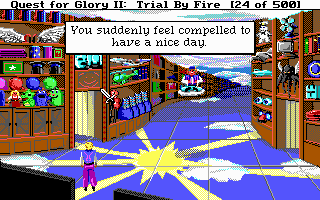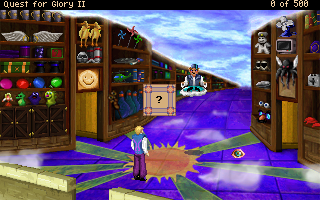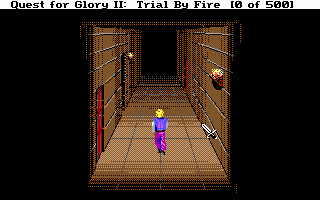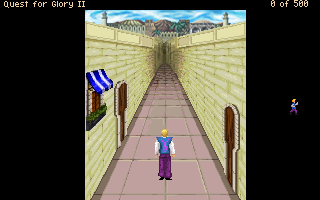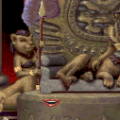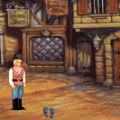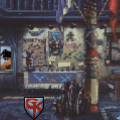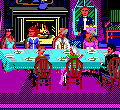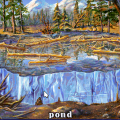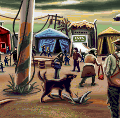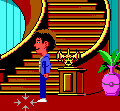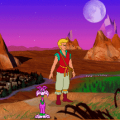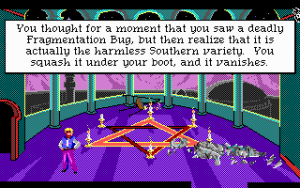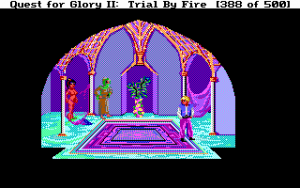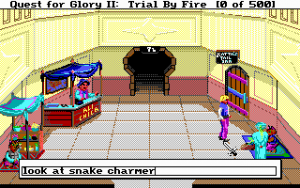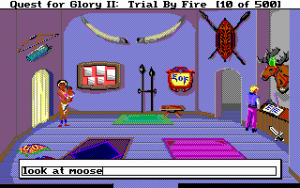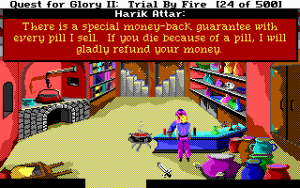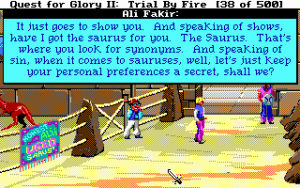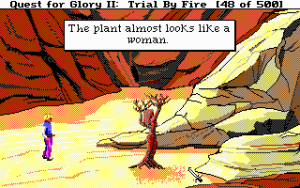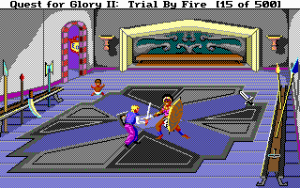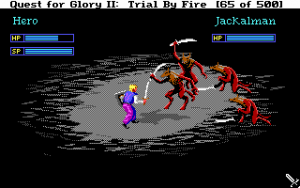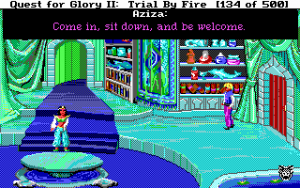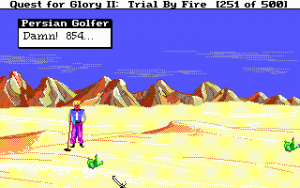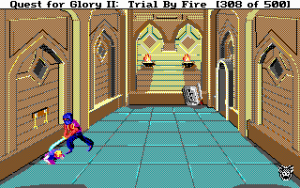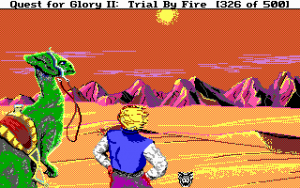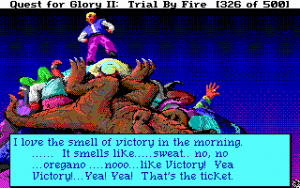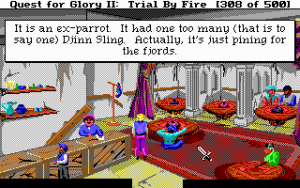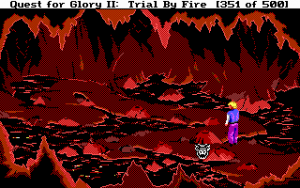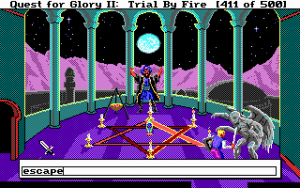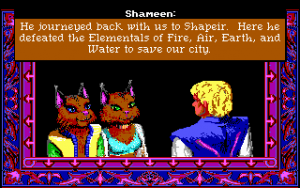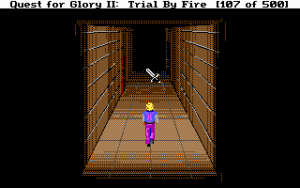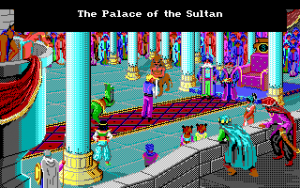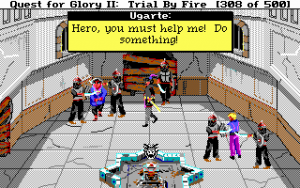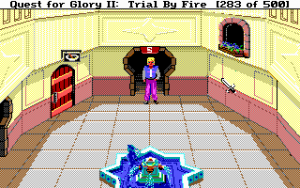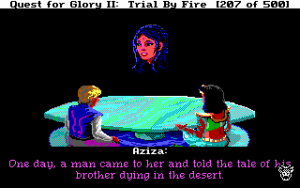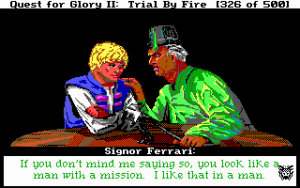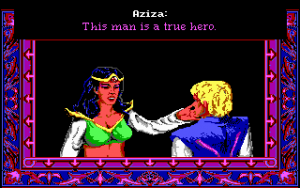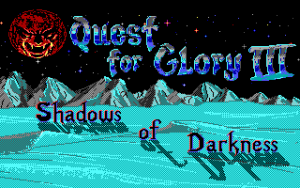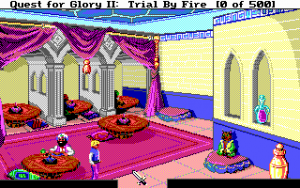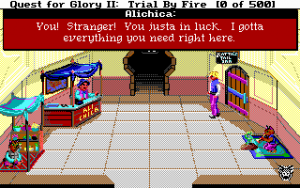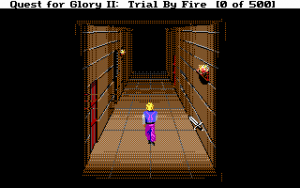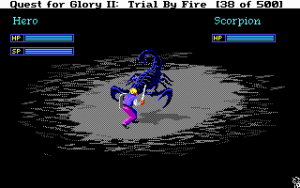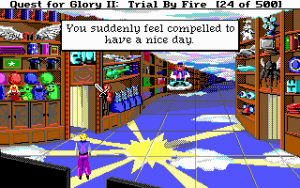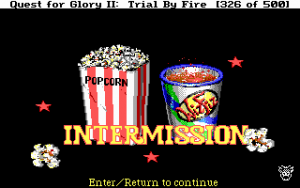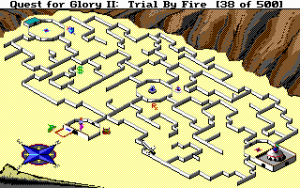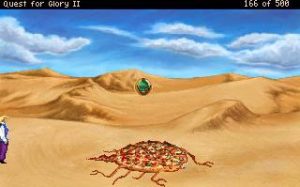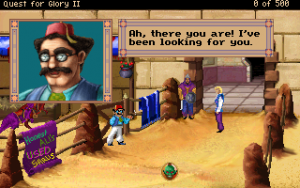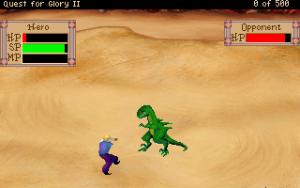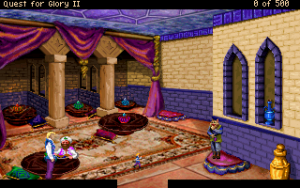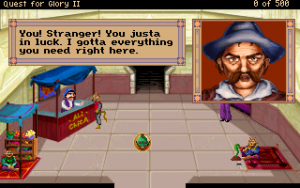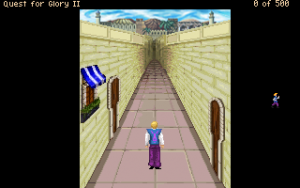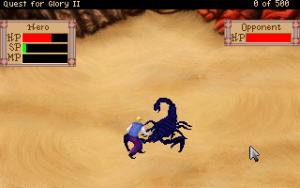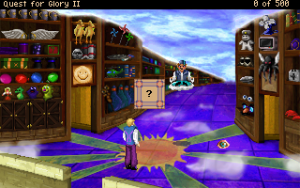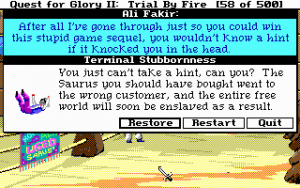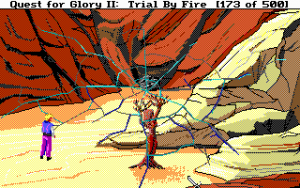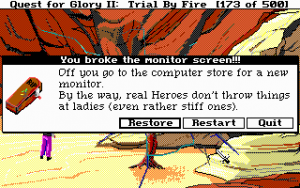Quest for Glory II, using the SCI0 engine, begins with our hero riding a magic carpet to the land of Shapeir, a desert country straight out of the Arabian Nights. All seems well for a few days, until the city comes under attack by a variety of troublesome elementals, who are based on earth, fire, wind and water, per RPG standards. After taking care of them, the hero will ride off to the crime ridden Raseir, Shapeir’s evil doppelganger city, which appears to be permanently devoid of light. Here, he must foil the plans of Ad Avis, who wishes to call the usual evil demons to rule the world.
The atmosphere in Shapeir is completely different from its predecessor. When you first get to the city you change into an appropriate outfit, ditching your old suit and cape. The music is appropriately Arabic flavored, although like many earlier adventure games it’s silent for a majority of the time. It’s also structured quite a bit differently. Rather than having a small town and a huge world to explore, Quest for Glory II flips that around, by having one gigantic town and a fairly small exterior world. Shapeir is an enormous city, filled with a labyrinth of streets that connect each of its five plazas. Whenever you enter one, the viewpoint switches behind the back of your hero, which can get extremely disorienting when you change directions. It also doesn’t help that your hero will keep walking forward until you hit a button to stop, making it difficult to walk through side doors. This is pretty standard for Sierra titles, but it definitely works against the game’s favor here. Using the mouse doesn’t really help much either.
One of your first tasks is to find the money changer so you can purchase some items. Of course, said money changer is also hidden in the depths of these winding roads. The idea is that you’re supposed to look at the map that comes bundled with the software, read the names of the streets, and carefully navigate to your destination. This is, naturally, pretty difficult, and it wouldn’t be surprising if many less devoted gamers simply gave up right here. Thankfully, once you get your cash, you can buy both a map and a compass from one of the vendors, which allows you to instantly warp to any previously visited location. Once you’ve found all of the major centers, there are only a couple of times you’ll ever need to break out the physical map and wade through the tunnels again.
The city itself is full of interesting characters. Two of the merchants bear suspicious resemblance to the Marx Brothers. The resident magician is a wacky little floating gnome, with a penchant for terrible puns and a room full of weird objects, including a Rosella doll, a Cookie Monster puppet, a squid with wings on it (narrator’s description: “You don’t want to know”) and an object so baffling that the game’s only description is a single question mark. Most of the residents include the cat-like Katta, and you spend much of your time at the inn run by your friend Shameen. On certain nights, you can even watch his wife seductively dance, which is a bit discomforting, given these are anthropomorphic cats. You can also find a helpful but ill-tempered fortuneteller in the depths of the city, who is vital to your quest but will have no problems tossing you out on your behind if you insult her.
Each class also has a unique optional quest to accomplish during the game. The Fighter can join the Eternal Order of Fighters, and the Magician can join the Wizard Institute of Technology (WIT), both accomplished by surviving through harsh tests. The Thief can hunt down the local guild and run specific quests for even more cash. Also new to Quest for Glory II are the Paladin quests, and alongside, the Honor statistic. If you act in accordance with the laws of the Paladin (which mostly amount to “don’t be a jerk”), you can eventually be promoted to this powerful class. However, this doesn’t happen until the end of the game, so you don’t actually get to use any of their skills. The idea is that you can import these into Quest for Glory III as a Paladin, but as it turns out, that game lets you choose to become a Paladin regardless of the deeds you accomplish here. Also new, and available to all character classes, is the Communication stat, which can be used to bargain with merchants. It’s all too easy to just continue to negotiate until your skill is high enough to convince them, so it is slightly broken.
Outside of the walls of Shapeir lies a vast desert. It stretches infinitely to the east and west, but there are only about five screens that separate the north and south borders of the game world. Compared to the Forest of Spielburg in the first Quest for Glory, you won’t spend nearly as much time navigating the desert – there are only a few locations to visit, and once you memorize the exact directions, they’re never more than a few screens away. In addition to food, you’ll also need a good supply to water to survive in the blistering heat, so make sure you fill your waterskins at every possible chance.
There are plenty of enemies roaming the desert, of course, although not nearly as many as the first game. The combat has changed to an isometric viewpoint, similar to what was used in the Quest for Glory I remake. However, there are many more combat options. While the rest of the games only give you two attack options – slash and thrust – there are numerous types of high, mid and low level attacks, in addition to parrying and dodging maneuvers. All of this is controlled by the numeric keypad. (Just make sure to turn Num Lock off!) While this should add depth to the fighting, it’s still based too heavily on your statistics, as attacks rarely seem to connect when they should, and it’s really just easier either to button mash or run away.
The biggest change from the previous game is that all of the events run on a very tight schedule. After the first days in town, one of the elementals will appear – if you don’t kill it within a couple of days, it’ll destroy the city. Once all four are defeated, you’ll automatically be taken to the city of Raseir, where time ceases to be much of an issue as the rest of the game plays out. Given how much freedom you have in all of the other Quest for Glory titles, it’s all aggravatingly linear.
There are more clever bits of humor too, including a cinematic sequence that begins with a homage to Lawrence of Arabia, which switches to an intermission (complete with popcorn and soda graphics) as you come under attack. The ensuing battle takes place off screen, and you somehow end up victorious over a pile of fallen bodies. The Blue Parrot Inn in Raseir is one huge tribute to Casablanca, cheekily borrowing Sydney Greenstreet’s Signor Ferrari and Peter Lorre’s Ugarte characters. In another slightly amusing Easter egg, you can buy a pair of X-Ray Glasses from the magician’s shop. These may seem useless, but you can use them to spy on one of the female characters when they’re changing clothes. It’s not particularly detailed, even compared to, say, Leisure Suit Larry III, but hey! Stuff like this is awesome when you’re thirteen. There’s even a cryptic “Silly Clowns” option in the menu bar, which causes some rather goofy stuff to happen through the game, like finding a Harpo Marx look-a-like running through the streets of Shapeir, or a doomed golfer permanently stuck in the desert sands.
Quite tragic is the story of Julanar, a woman who defied societal norms to become a healer. After being kidnapped by bandits, she escaped into the desert but found herself in a perilous situation. Upon hearing her cries for help, a genie “saves” her by turning her into a tree, which still bears some vague feminine features. You can aid her by giving her water, but only “true love” can set her free, which unfortunately the hero cannot provide. If you want to be a jerk, though, you can chuck a stone at her. In a brilliant fourth wall shattering move, it’ll bounce off and “crack” your computer monitor, complete with an electric hum and a Game Over message lamenting the fact that you’ll need to buy a new one.
Just one word of warning – the Quest for Glory games are usually pretty good about not sticking you in unwinnable situations. But after you beat all of the elementals, make sure to talk to all of the citizens, because one of them will give you a vital item. If you forget to get it – and it’s something very easy to overlook – then you’ll be completely stuck once you get to Raseir.
Despite a few of the aggravations, which you’ll mostly learn to avoid through multiple playthroughs, Quest for Glory II is a damn fine game. Although Sierra never released a VGA upgrade for Quest for Glory II, an awesome software development studio named AGD Interactive released their own remake in 2008 for Windows. The interface is pretty much the same one as Quest for Glory III, even using the same font. All of the writing is intact, all of the locations are beautifully duplicated with 256 color backgrounds, and all of the major (and most of the minor) characters have portraits when speaking. Although a majority of the interface is mouse driven, you have the option to enter text during the dialogue screens, in addition to choosing from multiple selections. The streets of Shapeir are now much brighter and less dingy, with street names helpfully popping up as you highlight them. There’s even an option to simplify the layout, which is still confusing, but much easier to navigate than the numerous twists and turns of the original game. All of the music has been redone too.
The developers at AGD also took the opportunity to expand the dialogue, including some notes from the Coles of things that had been left on the cutting room floor, and several additional Easter eggs. It also ties in together with the later games, allowing you to ask Rakeesh more about his life in Tarna from Quest for Glory III, or talk about Mordavia from Quest for Glory IV. There are a couple of new enemies, too – in Quest for Glory IV, the mad scientist talks about a hidden fifth “pizza” element. In this remake, there’s actually a hidden fifth pizza elemental you can fight, if you go through the right steps.
The battle system has been tweaked a bit as well. The screen no longer fades to a black screen during combat. You can now advance or retreat around the screen, allowing for a greater range of movement. You also regain a bit of stamina as long as you’re not attacking. If you want to forego most of this, there’s an auto-battle option too, which you can manually tweak. It’s still a bit hard to deal with, and fights tend to take longer than normal, but it’s also a huge improvement over the original. Since the remake was released as freeware with permission from Vivendi Universal (who held the rights to Sierra’s licenses at the time), it’s definitely worth downloading, and might even be preferable to the original, as long as you don’t have any nostalgic attachment to it.
